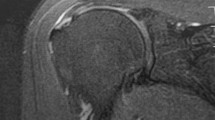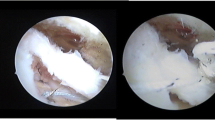Abstract
Purpose
Assessment of repair integrity and clinical outcome after arthroscopic repair of rotator cuff tears in double-row suture-bridge technique with the use of a new knotless suture-anchor system.
Methods
The first treated 25 patients with arthroscopic rotator cuff repair in the suture-bridge technique using a novel knotless anchor and chain-link suture system were evaluated. Patients with isolated full-thickness supraspinatus tears were selected. They were followed clinically with functional scores (Constant score, ASES index), visual analog scale (VAS), and instrumentally with Isobex digital strength analyzer preoperatively, at 6 and 14 months postoperatively. The repair integrity was evaluated with MRI at an average of 14 months postoperatively.
Results
Significant improvement of pain, strength, range of motion, and functional scores occurred (P < 0.05). There was a re-tear rate of 20%. The subjective parameters (VAS and ASES Index) showed non-significant (n.s.) differences between the re-tear and intact repair groups, whereas the objective parameters (Constant score, muscle power and active ROM) showed significant differences between both groups (P < 0.05).
Conclusion
The functional outcome has improved significantly with this new knotless anchor-chain system and was more superior in shoulders with intact repair, whereas the resulted repair integrity was not better than other types of double-row repair techniques mentioned in the recent literature. However, this early report of the novel technique may show limited power for comparison due to the relatively small sample size.



Similar content being viewed by others
References
Bigliani LU, Morrison DS (1986) The morphology of the acromion and its relationship to rotator cuff tears. Orthop Trans 10:228–234
Burkhart SS, Cole BJ (2010) Bridging self-reinforcing double-row rotator cuff repair: we really are doing better. Arthroscopy 26:677–680
Burkhart SS, Adams CR, Schoolfield JD (2009) A biomechanical comparison of 2 techniques of footprint reconstruction for rotator cuff repair: the SwiveLock-FiberChain construct versus standard double-row repair. Arthroscopy 25:274–281
Codman AE (1934) The shoulder: rupture of the supraspinatus tendon and other lesions in or about the subacromial bursa. Todd, Boston
Cole BJ, ElAttrache NS, Anbari A (2007) Arthroscopic rotator cuff repairs: an anatomic and biomechanical rationale for different suture-anchor repair configurations. Arthroscopy 23:662–669
Constant CR, Murley AH (1987) A clinical method of functional assessment of the shoulder. Clin Orthop Relat Res 214:160–164
Frank JB, ElAttrache NS, Dines JS, Blackburn A, Crues J, Tibone JE (2008) Repair site integrity after arthroscopic transosseous-equivalent suture-bridge rotator cuff repair. Am J Sports Med 36:1496–1503
Fuchs B, Weishaupt D, Zanetti M, Hodler J, Gerber C (1999) Fatty degeneration of the muscles of the rotator cuff: assessment by computed tomography versus magnetic resonance imaging. J Should Elbow Surg 8:599–605
Gerber C, Schneeberger AG, Hoppeler H, Meyer DC (2007) Correlation of atrophy and fatty infiltration on strength and integrity of rotator cuff repairs: a study in thirteen patients. J Should Elbow Surg 16:691–696
Goutallier D, Postel JM, Radier C, Bernageau J, Zilber S (2009) Long-term functional and structural outcome in patients with intact repairs 1 year after open transosseous rotator cuff repair. J Should Elbow Surg 18:521–528
Grimberg J, Diop A, Kalra K, Charousset C, Duranthon LD, Maurel N (2010) In vitro biomechanical comparison of three different types of single- and double-row arthroscopic rotator cuff repairs: Analysis of continuous bone-tendon contact pressure and surface during different simulated joint positions. J Should Elbow Surg 19:236–243
Harryman DT II, Mack LA, Wang KY, Jackins SE, Richardson ML, Matsen FA (1991) Repairs of the rotator cuff. Correlation of functional results with integrity of the cuff. J Bone Joint Surg Am 73:982–989
Huijsmans PE, Pritchard MP, Berghs BM, van Rooyen KS, Wallace AL, de Beer JF (2007) Arthroscopic rotator cuff repair with double-row fixation. J Bone Joint Surg Am 89:1248–1257
Kim KC, Rhee KJ, Shin HD (2009) Revision of a pull-out suture anchor in the lateral row during the suture-bridge technique: technical note. Knee Surg Sports Traumatol Arthrosc 17:1463–1465
Kim KC, Rhee KJ, Shin HD, Kim PS (2009) Arthroscopic footprint reconstruction of bursal-side delaminated rotator cuff tears using the suture-bridge technique. Knee Surg Sports Traumatol Arthrosc 17:840–843
Klepps S, Bishop J, Lin J, Strauss A, Hayes P, Flatow EL (2004) Prospective evaluation of the effect of rotator cuff integrity on the outcome of open rotator cuff repairs. Am J Sports Med 32:1716–1722
Lafosse L, Brozska R, Toussaint B, Gobezie R (2007) The outcome and structural integrity of arthroscopic rotator cuff repair with use of the double-row suture anchor technique. J Bone Joint Surg Am 89:1533–1541
Liu SH, Baker CL (1994) Arthroscopically assisted rotator cuff repair: correlation of functional results with integrity of the cuff. Arthroscopy 10:54–60
Nho SJ, Adler RS, Tomlinson DP et al (2009) Arthroscopic rotator cuff repair: prospective evaluation with sequential ultrasonography. Am J Sports Med 37:1938–1945
Park JY, Siti HT, Keum JS, Moon SG, Oh KS (2009) Does an Arthroscopic Suture Bridge Technique Maintain Repair Integrity?: A Serial Evaluation by Ultrasonography. Clin Orthop Relat Res. 468(6):1578–1587
Park MC, ElAttrache NS, Tibone JE, Ahmad CS, Jun BJ, Lee TQ (2007) Part I: footprint contact characteristics for a transosseous-equivalent rotator cuff repair technique compared with a double-row repair technique. J Should Elbow Surg 16:461–468
Patte D (1990) Classification of rotator cuff lesions. Clin Orthop Relat Res. 254:81–86
Richards RRBL, Friedman RJ, Gartsman GM, Lannotti JP (1994) A standardaized method for assessment of shoulder function. J Should Elbow Surg 3:347–352
Rockwood CABW (1988) Management of patients with massive rotator cuff defects by acromioplasty and rotator cuff debridement. Orthop Trans. 12:190–199
Snyder SJ (1993) Evaluation and treatment of the rotator cuff. Orthop Clin North Am 24:173–192
Spang JT, Buchmann S, Brucker PU, Kouloumentas P, Obst T, Imhoff AB (2009) A biomechanical comparison of 2 transosseous-equivalent double-row rotator cuff repair techniques using bioabsorbable anchors: cyclic loading and failure behavior. Arthroscopy 25:872–879
Sugaya H, Maeda K, Matsuki K, Moriishi J (2007) Repair integrity and functional outcome after arthroscopic double-row rotator cuff repair. A prospective outcome study. J Bone Joint Surg Am 89:953–960
Thomazeau H, Rolland Y, Lucas C, Duval JM, Langlais F (1996) Atrophy of the supraspinatus belly. Assessment by MRI in 55 patients with rotator cuff pathology. Acta Orthop Scand 67:264–268
Zanetti M, Gerber C, Hodler J (1998) Quantitative assessment of the muscles of the rotator cuff with magnetic resonance imaging. Invest Radiol 33:163–170
Acknowledgments
We thank Bettina Brenner for her great help in acquiring patients and collecting clinical data.
Author information
Authors and Affiliations
Corresponding author
Rights and permissions
About this article
Cite this article
El-Azab, H., Buchmann, S., Beitzel, K. et al. Clinical and structural evaluation of arthroscopic double-row suture-bridge rotator cuff repair: early results of a novel technique. Knee Surg Sports Traumatol Arthrosc 18, 1730–1737 (2010). https://doi.org/10.1007/s00167-010-1257-3
Received:
Accepted:
Published:
Issue Date:
DOI: https://doi.org/10.1007/s00167-010-1257-3




